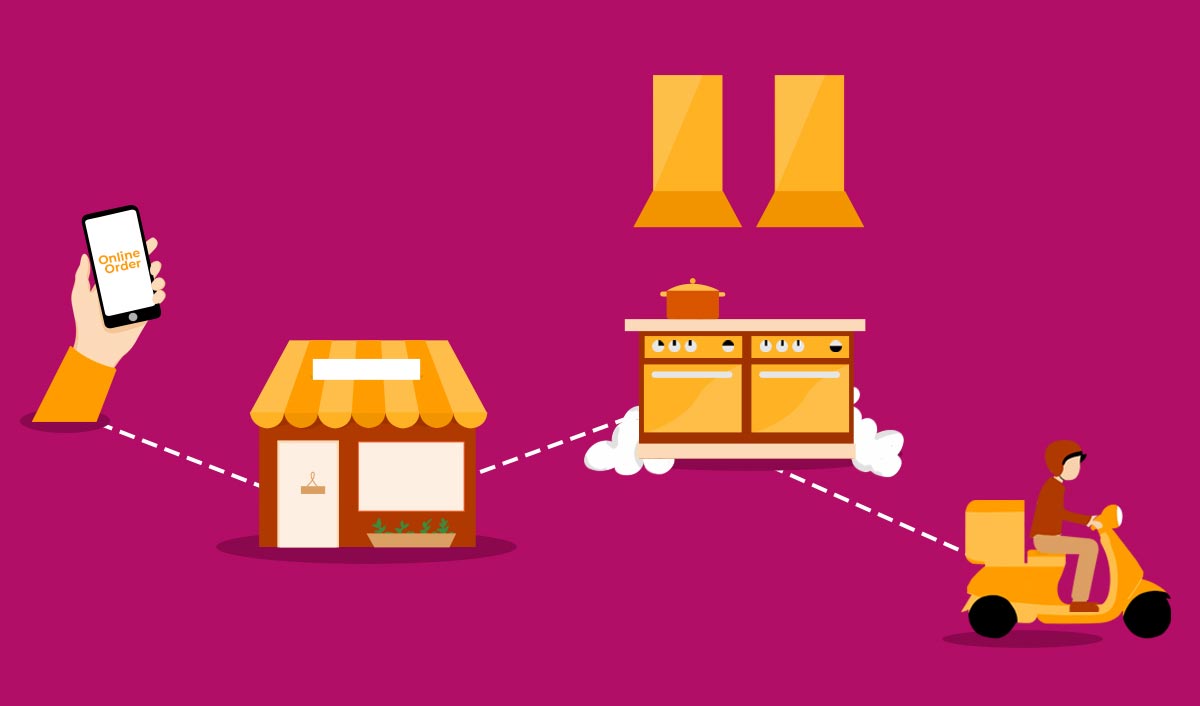
Important healthcare services have shifted online, given the rise of services like teleconsultation, e- pharmacy, e diagnostic services which are provided by brands like 1MG and Curefit where all the work is either done virtually or via a click.
But a human being cannot survive without food unless he’s from Krypton. This is the reason why food delivery or takeaway was declared as an essential service. But what exactly was the impact of lockdown on takeaway business?
As pandemic is forcing people to close their businesses, there is an increase in the listing of kitchens and restaurants which are ready to satiate your taste buds. The inpouring has been so huge that Swiggy is providing a platform called BrandWorks to cater to the growing needs of the consumers. Now and then a new takeaway restaurant pops up on Swiggy or Zomato.
This is because the pandemic has jumpstarted the rise of cloud kitchens also known as ghost kitchens or dark kitchens. These kitchens only provide takeaways and do not offer dine-in services, which are anyway not allowed under the current unlock rules. As dine-in is prohibited hotels and restaurants have adopted and focused on takeaway food to stay open and keep fighting.
But restaurants that are designed for dining services or not able to generate enough profits from takeaways. According to Crisil research footfall in restaurants is at an all-time low, the business is down to 10%. The institute estimates that a period of one year or more will be required to recover the business lost due to the pandemic. But restaurants that are especially started for takeaway are reporting huge profits. These takeaway restaurants are called cloud kitchens.
What is a cloud kitchen?
These kitchens do not have any establishment because they only offer takeaway. Offering takeaway services reduces the cost of posh dining infrastructure like tables, chairs, silverware, air-conditioning, expensive furniture, interior decoration, lights, live music, rent of an expensive location, serving staff, electricity etc. If all of these costs are put together, it makes a huge number and all of that money is saved. Cloud kitchens mostly rely on online orders placed on apps like Swiggy, Zomato or any other online food aggregators.
A minimum amount of fees is to be paid to food aggregators to be listed in their database, which is a lot less than traditional operation cost.
Established food brands can continue doing their business and new upcoming brands can fight to establish themselves even when everything is closed. Since cloud kitchens do not have to hassle for comfortable seating attractive menus, attractive interiors they save a lot of money, which means more profit and market share.
Apart from increased profit, this saved money can be used to deliver gourmet food at a low cost. The bachelors are always looking for good quality, hygienic food. The cloud kitchen industry is expected to grow five times in five years. Examples of successful cloud kitchens are Faasos, Meat Stock Exchange, Hub and Smoke, Biryani by Kilo etc.
Apart from cloud kitchen restaurants, there are cloud kitchen models where big private players invest in infrastructure for the kitchen and supports restaurants or chefs to deliver food.
What are the different models of cloud kitchens?
- Independent cloud kitchen model – this was the original cloud kitchen model where a single brand and single kitchen offers food for takeaway. This concept gained endorsement with the onset of food delivering application. These kitchens usually specialise in a particular cuisine and are partially dependent on the online food aggregators to get orders.
- Rebel foods business model – these models are very clever and use data judgment such as a demographic profile of an area, choice of cuisine and infrastructure for demand and supply. These models exploit that database and serve popular cuisines say biryani in a particular area where fewer restaurants serve biryani. In another area, this model may be serving chinese food. So under a single brand and single kitchen, multiple cuisines are served to help them establish themselves. Since there is no store and single kitchen operational cost is low.
- FreshMenu business model – this is a combination of takeaway restaurant and cloud kitchen which caters to the needs of the consumers accordingly. Most of the work is done via cloud kitchen but a physical establishment offers takeaway services to establish human contact. These are partially dependent on online food aggregators. Their cuisine change according to seasons and choice of customers.
- Swiggy Access business model – this is a venture where big players like Swiggy invest in infrastructure like state of the art kitchens with all facilities like gas, ventilation, drainage etc. These kitchens are ready to use, a chef or restaurant is allowed to rent the kitchen space.
- Swiggy in exchange for a fee offers them listing on their online order database, provides them delivery services and also helps with the menu. The restaurant has to bring their raw material and staff. Its motto is ‘you cook and let us do the rest’. Under this model, multiple restaurants can work in a single kitchen and exploit Swiggy brand services.
- Zomato infrastructure services business model-This model is similar to Swiggy but it has a storefront. It’s a combination of cloud kitchen, takeaway restaurant and aggregator model. Like Swiggy, Zomato also provides state of an art kitchen with all facilities, delivery services and enlisting on online database. Customers here have the option of walking into the storefront to see how the food is prepared.
- The Kitopi Business model– this model is a little different from the models discussed above as it is exclusively made for restaurants or cloud kitchens. In this model, a kitchen can order say semi-cooked food, marinated meat, curries, sauces et cetera and the restaurant’s chef give final touches. After the food is prepared Kitopi delivers it.
How can one start a cloud kitchen?
Starting a cloud kitchen what one needs is off the charts culinary skills and kitchen. Apart from that few licenses are required before the kitchen is functional.
- License from FSSAI – licence from the Food Safety and Standards Authority of India is required. These licences are compulsory for all food-related businesses in India and must be obtained by the owner or by the company. Licenses range from 1 year to 5 year period. Since FSSAI cannot visit the stores (because there is no store) for sanitation and safety checkups cloud kitchens are required to procure this license.
- GST registration – GST registration is mandatory for any business be it cloud or off-line. GST has to be submitted weekly, quarterly and annually. GST license helps us to procure legal vendors and reduces the tax amount if everyone has a GST number.
- Trade license – every business in India requires this license. This can be obtained from municipal offices.
- Fire and safety licence – this licence is not mandatory but is advised. To save oneself from legal troubles fire and human health approvals are unavoidable.
- Trademark – Every business needs a mark that is unique and helps consumers identify them.







